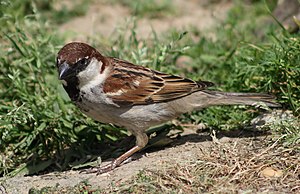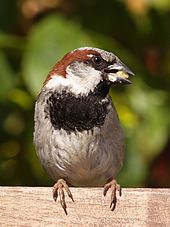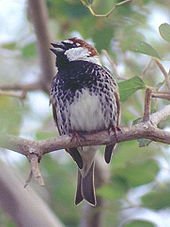Italian sparrow
| Italian sparrow | ||||||||||||
|---|---|---|---|---|---|---|---|---|---|---|---|---|

Italian Sparrow (male) |
||||||||||||
| Systematics | ||||||||||||
|
||||||||||||
| Scientific name | ||||||||||||
| Passer italiae | ||||||||||||
| ( Vieillot , 1817) |
The Italian sparrow ( Passer italiae ) is a population group of sparrows that is very similar to the willow sparrow ( Passer hispaniolensis ) and the house sparrow ( Passer domesticus ). The Italian sparrow can be found on the Apennine peninsula , on Corsica and on Crete . It occurs there largely without the two closely related species of willow sparrow and house sparrow and thus represents both of these species in the area. The taxonomic status of the Italian sparrow is extremely controversial; in addition to being classified as an independent species, it was and is viewed as both a subspecies of the house and willow sparrow. The evolutionary origin of the Italian sparrow is also controversial; it has been assumed for a long time that it originated from a stabilized hybridization of house and willow sparrows, although this is highly doubted today.
Appearance
In appearance, the Italian sparrow lies between its two assumed parent species and can hardly be distinguished from hybrids that develop spontaneously elsewhere: As with the willow sparrow, the head, forehead and neck are lively chestnut brown, sometimes also reddish brown. The cheeks are almost pure white, not dirty gray-white like the house sparrow. A fine white stripe above the eyes is usually clearly visible. The throat patch is pure black, the flap is more clearly flocked black than that of the house sparrow. In the rest of the body plumage, the Italian sparrow is again very similar to the house sparrow, but its back and rump are also brownish and not gray. The females of the Italian sparrow can hardly be distinguished in the field from those of the house sparrow, and from those of the willow sparrow only with great difficulty.
distribution
The Italian sparrow is the most common bird species on the Apennine Peninsula . Its distribution to the north is limited by the Alpine arc. South of the Alps there is a rather abrupt transition zone, approximately 35 to 40 kilometers wide, between the populations of the house and Italian sparrows, in which hybridization is also common. Phenotypically pure Italian sparrows also reach Tyrolean valleys north of the Alps and occasionally appear in southern Carinthia.
In contrast to the rather abrupt species transition to the house sparrow in the north, the Italian sparrow is connected to the willow sparrow in the middle and south of Italy by a wide, flowing transition zone.
The Italian sparrows in Corsica are similar in appearance to those of northern Italy, and the transition to the willow sparrows in Sardinia is quite clear here. Also Crete has been inhabited by Italian Sparrow.
habitat
Like the house sparrow, the Italian sparrow is a resident of cities, villages, and agricultural estates. It is a pronounced resident bird with no tendency towards the nomadic way of life of the willow sparrow.
nutrition
Its diet consists of all kinds of seeds; Animal food is consumed to varying degrees depending on availability, but its share of the total does not significantly exceed 10%.
Taxonomic discussion
The taxonomic classification of the Italian sparrow has always been controversial since its description almost 200 years ago and is still not cleared up today. The appearance of the plumage of the males of the Italian sparrow is clearly somewhere between house and willow sparrows , whereas the females of all three species are very similar. House sparrows and willow sparrows are considered to be different species, as they occur sympatricly in many areas without hybridization occurring. Everything else is controversial, the main questions are discussed below.
How did the Italian sparrow come about?
The hypothesis that is still most common today was mainly shaped by Wilhelm Meise , who put forward the thesis in 1936 that the Italian sparrow is a stabilized hybrid of house and willow sparrows. He justified this thesis, among other things, with the fact that in oases in eastern Algeria and Tunisia there is still hybridization between willow sparrow and the subspecies tingitanus of the house sparrow, and that hybrids there look very similar to the Italian sparrow. There is also a broad transition zone between willow sparrow and Italian sparrow in the south of Italy and a zone in the north in which the Italian and house sparrows hybridize. Furthermore, the Italian sparrows in the north are more similar to the house sparrows, those in the south more to the willow sparrows, and there is a gradual transition. Thus, the Italian sparrow seems to be very close to both supposed ancestor species.
All scenarios to explain the hybridogenic origin of the Italian sparrow assume three phases: In the first phase there is extensive hybridization between the two parent species, in the second phase there is a geographical isolation of the hybrid form (for example due to increasing glaciation during the Pleistocene ) can thereby stabilize. In the third phase, the hybrid form comes into contact with both parent species again, and hybridizations again occur, which influence the delimitation of the species.
Species formation through hybridization is not uncommon in the plant world, but in the bird world all such assumptions have so far not been confirmed. Nevertheless, this thesis of the origin of the Italian sparrow was accepted and even viewed as a prime example of species origin through stabilized hybridization.
Meise's work greatly influenced ornithologists in the period that followed. It was not until a long time later that Burkard Stephan first pointed out that Meise's argument contained a circular argument , as he already defined a feature index in the starting position of his work in such a way that the Italian sparrow is located exactly between the willow and house sparrow and thus speciation through hybridization already implicitly assumed.
Alternatively, a “conventional” species origin of the Italian sparrow is assumed, although it is still unclear whether this is a separate species or a subspecies of the house or willow sparrow. Another hypothesis in this context is that the Italian sparrow represents an intermediate stage in the species separation of house and willow sparrows.
Who is the Italian sparrow closer to?
Regardless of origin and taxonomic status, the question of whether the Italian sparrow is closer to the house sparrow or the willow sparrow is still controversial today. From an ecological point of view, the Italian sparrow seems to be closer to the house sparrow, because like the house sparrow it is also an outspoken cultural follower. The wide zone of flowing transition between Italian and willow sparrow in southern Italy as well as the rather abrupt transition between Italian and house sparrow in the Alps suggest that the willow and Italian sparrow are more closely related, whereby it should be noted that Wilhelm Meise did the abrupt one in 1936 The transition between house and Italian sparrows in the Alps was seen somewhat arbitrarily as a reason to assign the Italian sparrow to the house sparrow as a subspecies, which in turn influenced many researchers in the subsequent period.
Scientific studies carried out in the past have come to different conclusions. A lot of research published at the end of the 20th century, which in addition to the classic working methods also included bioacoustics , reproductive biology , molecular genetics and chromosome studies , shows that the Italian sparrow has much more in common with the willow sparrow than with the house sparrow.
In contrast to this is a study carried out in 1988 of the gene segments of 15 polymorphic isozymes , which dates a period of only 15,300 years for the splitting of the Italian sparrow from the house sparrow and, in contrast, the splitting off of the Italian sparrow from the willow sparrow to 113,300 years ago. In 2001 the mitochondrial gene sequence of the cytochrome -b and other mitochondrial pseudogenes of at least two different individuals of the participating species were examined. These analyzes also show fewer differences between Italian and house sparrows (deviation 0.54%) than between Italian and willow sparrows (deviation 2.66%) and thus suggest a closer relationship between house and Italian sparrows. A DNA analysis of microsatellites carried out in 2002 , which suggests the origin of the Italian sparrow from a willow sparrow population , contradicts these two molecular genetic studies .
Is the Italian sparrow a separate species?
The Italian sparrow was originally described as a separate species ( Fringilla italiae Vieillot 1817). In the meantime it has been - and still is - considered a subspecies of the house sparrow ( P. domesticus italiae ) or a subspecies of the willow sparrow ( P. hispaniolensis italiae ). Taking into account the thesis of hybridogenic origin, it is also classified as Passer x italiae . In order to avoid the problem of the unclear origin of the species, it is seen as a separate species, especially for practical reasons ( Passer italiae ).
A lot speaks for the classification as a subspecies of the willow sparrow today, including the smooth transition between the sparrow populations in southern Italy. It should be noted that, according to the taxonomic priority rules, the correct names for Italian sparrows and willow sparrows should actually be Passer italiae italiae and Passer italiae hispaniolensis , since the older name is used as the species name for species with subspecies.
It is also interesting that in the 1990s in central and northern Italy near Foggia and in the Po Delta a pure willow sparrow population immigrated, the population of which is growing steadily. These willow sparrows do not seem to mix with the Italian sparrows that live there. According to the established rules, however, a period of at least 25 years or 3 generations must be awaited for neozoa to be considered as established. Then the species status of the Italian sparrow would have to be reconsidered.
Individual evidence
- ↑ a b c Till Töpfer (2006): The taxonomic status of the Italian Sparrow - Passer italiae (Vieillot 1817): Speciation by stabilized hybridization? A critical analysis ; Zotaxa 1325; 117-145. Abstract (PDF file; 18 kB)
- ↑ a b c Till Töpfer: The story of the Italiensperling ; see literature
- ↑ B. Stephan (1986): The theory of evolution and the taxonomic status of the Italiensperling ; In: Mitteilungen des Zoological Museum Berlin , 62; Supplement Annals for Ornithology , 10, 25-68
- ↑ DT Parkin (1988): Genetic Variation in the House Sparrow (Passer domesticus) ; In: Ouellet, H. (Ed.), Acta XIX Congressus Internationalis Ornithologici. Vol. II, 1652-1657
- ↑ Allende et al. (2001): The old world sparrows (Genus Passer) phylogeographie and their relative abundance of nuclear mtDNA pseudogenes ; In: Journal of Molecular Evolution ; 53; 144-154
- ↑ M. Milone et al. (2002): Genetic approaches to the systematics and range of the Italian Sparrow, Passer italiae ; In: Proceedings of 23rd International Ornithological Congress Beijing ; China (Abstract Volume); 109; 332-333.
- ↑ Ted. R. Anderson: Biology of the ubiquitous house sparrow: from genes to populations ; Oxford University Press 2006; ISBN 0-19-530411-X ; p. 13-18
literature
- Till Töpfer: The story of the Italian sparrow ; In: Der Falke 54; 250-256; Edition 07/2007; ISSN 0323-357X
- UN Glutz von Blotzheim , KM Bauer : Handbook of the birds of Central Europe (HBV). Volume 14-I: Passeriformes. 5th part. AULA-Verlag 1997, ISBN 3-923527-00-4 .




